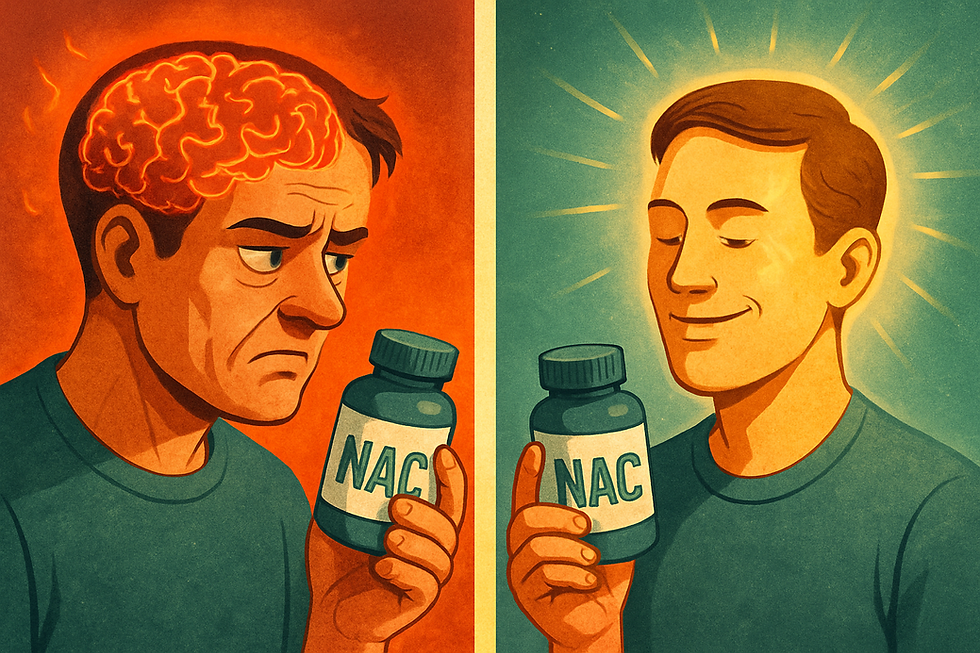Mindfulness: How to Train Your Brain Without Losing Your Snacks
- ryanshortpmhnp
- Aug 10
- 5 min read
Updated: Aug 18

Mindfulness Practice for Mental Health: Evidence and Practical Guidance
If you’ve ever found yourself halfway through a bag of chips without remembering how you got there, congratulations — you’ve already experienced the opposite of mindfulness. The good news? Mindfulness is a skill you can build, and research shows it’s one of the most versatile tools for improving mental health, reducing stress, and helping you actually taste those chips.
Mindfulness isn’t about sitting on a mountain in a robe (unless that’s your thing). It’s about paying attention — in the moment, without judgment — to what’s happening in your mind, body, and surroundings. While it sounds simple, the science behind it is impressive, and its benefits can show up in surprisingly practical ways. Think of it as a mental Swiss Army knife — small, portable, and strangely useful in situations you didn’t expect.
Four Different Kinds of Mindfulness
Mindfulness Meditation This is the classic “sit quietly, focus on your breath” style. You notice thoughts and sensations as they come, acknowledge them without judgment, and gently return your focus to a single anchor (like the breath, a mantra, or even the feeling of your feet on the floor).If you’re picturing a monk in perfect serenity, don’t worry — most people spend their first few sessions thinking about lunch or wondering if they left the dryer running. That’s normal.
Body Scan This involves mentally scanning your body from head to toe, noticing sensations without trying to change them. It’s like giving your nervous system a slow, gentle check-in — great for relaxation and increasing awareness of tension you didn’t even know you were carrying. Bonus: you can do this in bed and no one will judge you for accidentally napping.
Mindful Movement Think yoga, tai chi, or even a slow walk where you notice each step and breath. It’s perfect for people who can’t sit still (or don’t want to), blending physical activity with mental presence. Bonus: it doubles as gentle exercise, so you get both the mental benefits of mindfulness and the physical perks of moving your body. Also, if you’re walking slowly in public, you can pretend you’re in a nature documentary about “The Majestic Urban Human” — just don’t be surprised if someone tries to speed past your migration route.
Informal Everyday Mindfulness No yoga mat required. This is simply paying attention to everyday activities — brushing your teeth, making coffee, or eating — with full awareness. The trick is to focus on the sensory experience instead of running through your mental to-do list. It’s amazing how different your morning toast tastes when you’re not simultaneously emailing your boss and Googling “why is my cat staring at me.”
Mental Health Conditions That Can Benefit
While mindfulness isn’t a magic cure (sorry, no unicorn-level miracles here), research supports its use as a helpful part of treatment or prevention for several conditions:
Anxiety disorders – Helps break the cycle of worry and overthinking.
Depression – Supports emotional regulation and reduces relapse risk.
Post-traumatic stress disorder (PTSD) – Encourages grounding in the present moment, which can reduce flashback intensity.
Obsessive-compulsive disorder (OCD) – Creates space between intrusive thoughts and compulsive responses.
Chronic stress – Lowers physiological stress markers like cortisol.
Substance use disorders – Can improve impulse control and emotional stability during recovery.
Getting Started in Different Forms
If mindfulness is new to you, think of it like exercise for your brain — you wouldn’t run a marathon on day one, so you don’t need to meditate for an hour right away. Start small. (And unlike actual exercise, you can do mindfulness without sweating. Unless your AC is broken. Then… sorry.)
Mindfulness Meditation – Start with 3–5 minutes. Sit comfortably, close your eyes if you like, and notice your breath. When your mind wanders (and it will), gently bring it back — no guilt, no self-judgment. That “bringing back” is the actual workout. Congratulations, you’re officially a mental athlete.
Body Scan – Lie down or sit somewhere quiet. Move your attention slowly from the top of your head to your toes, noticing sensations without trying to change them. If you find tension, acknowledge it and move on. A guided audio can help — otherwise you might suddenly find yourself thinking about tacos halfway through.
Mindful Movement – Try a beginner yoga or tai chi video. Or just go for a walk and notice your breathing, the feeling of your feet on the ground, and the sights and sounds around you. Keep your phone in your pocket unless you’re using it for instructions. (Yes, that means not scrolling Instagram while “being mindful.”)
Informal Mindfulness – Pick one daily activity and do it mindfully. Eat a meal without TV or scrolling. Pay attention to flavors, textures, smells. You might discover your lunch tastes way better when you’re not multitasking. Or you might realize your cooking could use a little more salt — both are useful insights.
Good Sources for Learning Mindfulness
Podcasts
Ten Percent Happier with Dan Harris – Practical, down-to-earth interviews and guided practices.
The Mindful Minute – Short episodes focusing on approachable techniques.
YouTube Channels
The Mindful Movement – Free guided meditations, body scans, and gentle yoga.
Yoga with Adriene – Friendly, accessible yoga with a focus on presence.
Apps
Free Options
Insight Timer – Thousands of free guided meditations from teachers worldwide.
Smiling Mind – A nonprofit app offering free mindfulness programs for all ages.
Healthy Minds Program – Science-based training in mindfulness and well-being, completely free.
Paid Options
Headspace – Beginner-friendly with structured courses; $12.99/month or $69.99/year.
Calm – Combines mindfulness with sleep stories and relaxation exercises; $14.99/month or $69.99/year.
Final Thoughts
Mindfulness isn’t about emptying your mind or becoming perfectly calm. It’s about noticing — without judgment — what’s happening right now. Whether you choose meditation, movement, or simply paying closer attention to your morning coffee, consistency is more important than perfection.
You don’t have to become a Zen master overnight. In fact, you don’t have to “master” it at all — the beauty of mindfulness is that it’s a lifelong practice, and even a few mindful minutes a day can make a meaningful difference for your mental health. Worst case scenario? You at least get to enjoy your snacks more.
References
American Psychological Association. (2021). Mindfulness meditation: A research-proven way to reduce stress. https://www.apa.org/topics/mindfulness/meditation
Baer, R. A. (2003). Mindfulness training as a clinical intervention: A conceptual and empirical review. Clinical Psychology: Science and Practice, 10(2), 125–143.
Creswell, J. D. (2017). Mindfulness interventions. Annual Review of Psychology, 68, 491–516.
Kabat-Zinn, J. (1994). Wherever you go, there you are: Mindfulness meditation in everyday life. Hyperion.
Khoury, B., Lecomte, T., Fortin, G., Masse, M., Therien, P., Bouchard, V., … Hofmann, S. G. (2013). Mindfulness-based therapy: A comprehensive meta-analysis. Clinical Psychology Review, 33(6), 763–771.
Shapiro, S. L., Astin, J. A., Bishop, S. R., & Cordova, M. (2005). Mindfulness-based stress reduction for health care professionals: Results from a randomized trial. International Journal of Stress Management, 12(2), 164–176.




Comments